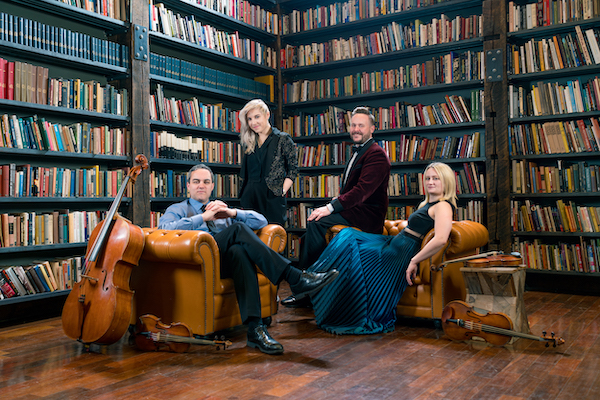Thorvaldsdóttir premiere leads an atmospheric evening with Spektral Quartet

When the Spektral Quartet comes to town, they bring a bevy of new music with them. Last here for two daring all-modern programs at the Library of Congress in 2018, the Chicago-based ensemble took the stage of the Kennedy Center Terrace Theater Tuesday night with a mixture of old and new music.
The presenter, Washington Performing Arts, co-commissioned the evening’s high point, Enigma, the first string quartet by Anna Thorvaldsdóttir, heard in its world premiere.
The musicians felt so strongly about the opening musical pairing, Tomás Luis de Victoria’s motet O Magnum Mysterium and Eliza Brown’s String Quartet No. 1, that they asked the audience not to applaud between them. This drew attention to some similarities in musical motifs between the two works. In particular, the interval of a perfect fifth, heard in the motet’s first point of imitation, was echoed but then obscured with other sounds in Brown’s piece.
In theory having a string quartet take the parts of a four-voice choral work should work perfectly, eliminating potential vocal shortfalls like breath support of long lines. In practice, balance and intonation were not always ideal, possibly related to the scordatura tuning of the cello required for the Brown piece and also used here. Throughout the evening the two violinists sometimes seemed in a separate sound pocket from violist Doyle Armbrust and cellist Russell Rolen.
Brown wrote her first, and so far only, string quartet in 2011, when it was premiered by the then brand-new Spektral Quartet, and revised it in 2013. The stage lights, darkened for the Victoria piece, slowly came back up at the beginning of the piece. In the words of the composer, who teaches composition and music theory at DePauw University, “the elements of an original, functional chord progression are taken apart and brought in and out of focus, as though one is hearing the progression through the constantly adjusting lens of an aural microscope.”
Scratchy harmonics and pulsed patterns of repeated notes obscured the opening fifth, into which a minor third gradually slipped, again hearkening back to the mode of the Victoria motet. Armbrust’s manic viola solo at about the midpoint of the work led into a blossoming major chord climax, an exceptional break in a work that lacked textural and harmonic variety.
At the start of Beethoven’s String Quartet No. 16, Armbrust’s jaunty take on the quirky viola motif set a joyful tone for the composer’s last complete quartet. Scholar Joseph Kerman noted a “self-conscious classicism” in the work, in which Beethoven “turns sharply back, not forward, more so than any other work in a decade.” For this piece violinists Maeve Feinberg and Clara Lyon switched places, but with Lyon on first the issues of scratchy intonation, especially in high passages, continued.
The brief Scherzo movement was spirited, but the colossal slow movement, the pensive variations that are the quartet’s heart, felt perfunctory rather than expansive. The best moments came in the humorous finale, with the introspective opening question (“Must it be?,” as Beethoven wrote in the score) answered by a rambunctious, tumbling response (“It must be”).
It seemed that the space and calm missing from Beethoven’s slow movement was saved up for the new piece, Anna Thorvaldsdóttir’s Enigma, which the composer described as “pulsating stasis . . . contrasted with fragmented materials.” Inspired in part by the memorable experience of the total solar eclipse that crossed part of the United States in August 2017, the 27-minute work is a meditative slow burn.
Pitchless tremolo buzzing punctuated the music, augmented by amplification that heightened the sense of echo effects at times. Washes of chords, often clustered with dissonance, morphed in and out of perception. Major themes appeared throughout the course of what seemed like three movements: glissando sighs like seagull cries, and the descending minor tetrachord of the chaconne (do-te-le-sol in solfege), a universal signifier of lament. This last theme was often layered upon itself in polyphonic imitation streaming slowly downward.
While the outer movements felt slow and almost shapeless, the inner movement pulsated with more active rhythms. The music is paired with a visual component, a mysterious and equally slow-moving video by Sigurður Guðjónnson, an Icelander like Thorvaldsdóttir. Made with “high-powered cameras working at a microscopic level,” according to Armbrust’s program notes, the images change at a glacial pace, with tiny shapes seeming to grow and expand in a hallucinatory way as one picture melts slowly into the next.
The effect of music and video should only be heightened when it is performed as actually intended, with the images projected on a 360-degree dome screen, rather than a smaller flat screen. This will happen for the first time June 11 and 12, 2020, at the Adler Planetarium’s Grainger Sky Theater in Chicago. Thorvaldsdóttir’s Enigma will have its Chicago premiere November 14.
